This is the second in the series of Quick Guides to deal with Trinidad’s common butterfly species. The species listed below are usually found in shady, well vegetated areas including, but not limited to, the forest undergrowth and along forest trails. Some species may also be attracted to gardens if a similar moist and shady habitat is available.
Erato Longwing (Heliconius erato)
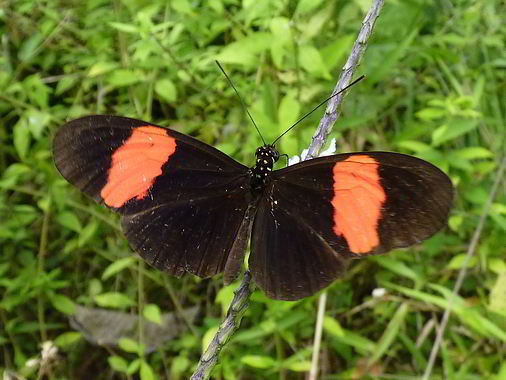
Commonly known as the “Postman”, this attractive member of the Heliconiinae family is common in suitable habitat and can sometimes be found in large numbers feeding at forest flowers. They are identified by their black wings which are crossed by a broad red band and by the four red spots at the base of their wings on the underside. They are weak fliers and avoid windy areas, preferring to keep to the undergrowth and forest edge. Members of the Heliconiinae family are some of the only species of butterflies known to ‘eat’ pollen. Intentional or not, this behavior provides the butterfly with amino acids that may extend their lifespan. (Note: There is another very similar “Postman” which can be found in Trinidad. It is H. melpommene and it is easily identified by three red spots at the base of the wing on the underside.)
Agnosia Clearwing (Ithomia agnosia)
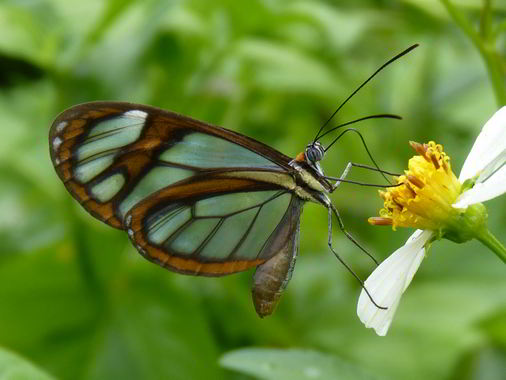
Similar to the Heliconiinae, the “Blue Transparent”, as it is know locally, is actually a member of the Ithomiinae family. It has delicate glass-like wings which are tinged with blue when seen in the right light (and often in photos illuminated by flash). This butterfly is commonly seen along forest roads and favours moist areas, often in the vicinity of streams and usually in shady conditions.
Polymnia Tigerwing (Mechanitis polymnia kayei)
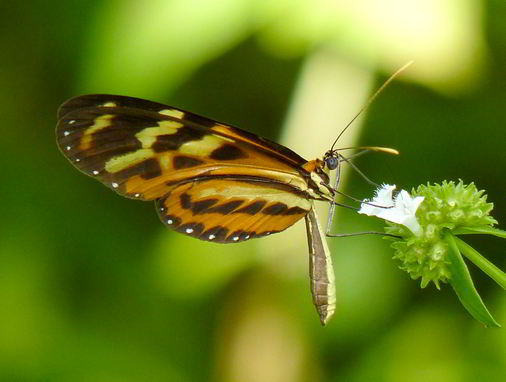
Known locally as the “Sweet Oil”, this common member of the Ithomiinae family is boldly marked with yellow, orange and dark brown. This pattern of colouration is utilized by several species of butterflies, both in an attempt to signal to potential predators that they (the butterflies) have a bad taste and should therefore be avoided or in an attempt by perfectly edible species to mimic the bad tasting species.
Molpe Metalmark (Juditha molpe)
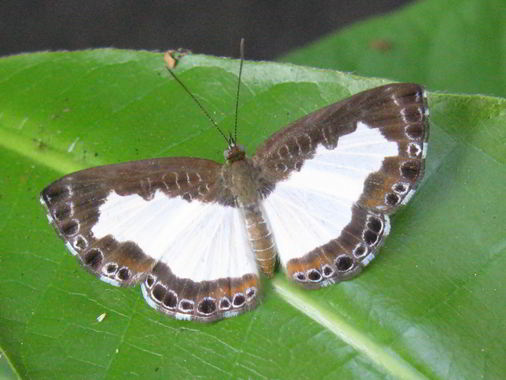
This evasive butterfly is a member of the Riodinidae family and, like most members of this family, they have a habit of resting on the underside of leaves which can make observation rather tricky. Thankfully they will usually keep their wings outstretched allowing for easier identification. Juditha molpe appears to be a variable species in that the wing patterning can vary slightly between individuals. The basic pattern has a white internal area surrounded by brown with darker spots, which are themselves circled in white.
Electron Pixie (Melanis electron)
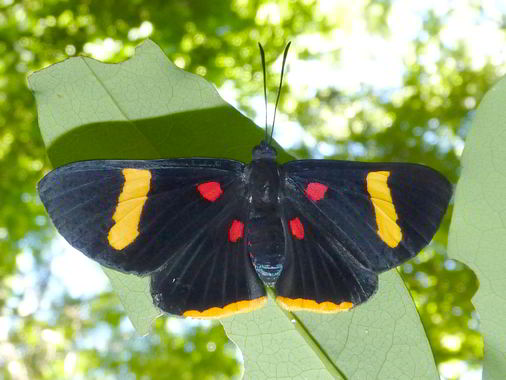
Another member of the Riodinidae, this species shares the habit of leaf hiding and gave rise to Malcom Barcant’s local name of “Underleaf”. It is attractively patterned being black with four orange orbs (resembling electrons in a traditional interpretation of an atom’s structure).
Common Morpho (Morpho helenor insularis)
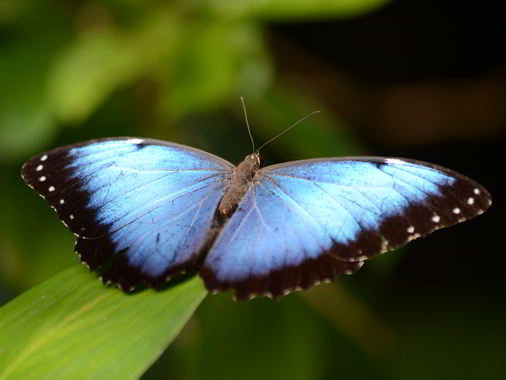
The Morpho is an iconic resident of shady forests and woodland. This is the butterfly frequently encountered on forest trails and roads as it flutters by with iridescent blue wings and in a characteristic dipping motion. It is known locally as the “Emperor” and it is the symbol of the Emperor Valley Zoo, so named after this butterfly which frequents the valley behind the zoo. It is not usually encountered at rest with its wings spread, instead it often keeps them closed, exposing the cryptically camouflaged underside.
Illioneus Giant-Owl (Caligo illioneus)
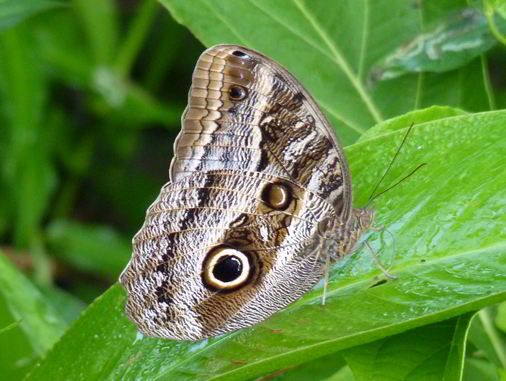
Locally known as the Cane Mort-Bleu, the Illioneus Giant-Owl is a large butterfly that emerges at dusk in search of ripe fruit. It may also be encountered at rest during the day in the deep shade of forest undergrowth. Widely distributed, it sometimes enters homes in the evening. The underside of this butterfly is cryptically marked with two large eyespots. The upper-side is purple with dark edges. There are three similar species of Giant-Owl butterfly found in Trinidad and Tobago.
Aetolus Lycid (Arawacus aetolus)

The “White Lycid” is a common member of the Lycaenidae family. It is usually encountered sitting on leaves in cool shady areas or as it flies off, briefly exposing its white upper-side. The underside of its wings is beautifully striped with dark brown, white and orange.
Members of the Lycaenidae family are usually found resting on leaves in cool, moist areas, often rubbing their hind-wings together. This is believed to draw attention to the antenna like projections on their lower wings, which superficially resembles antennae and thus presents a false head to would be predators, in order to draw attention away from its real head. To complete the act, when threatened they often rotate slowly and present their false head to the perceived threat. Alternatively, the wing rubbing may serve to disburse pheromones. Members of the Lycaenidae are almost always found with their wings held vertically and closed.
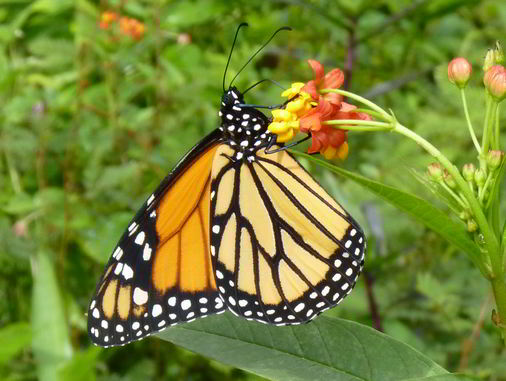
Monarchs are easily identified by their bright orange colour and black wing veins. They are found in a wide variety of habitats but are especially common is area where the Milkweed (Asclepias curassavica) grows as this plant is the food-source of the Monarch’s caterpillars. The Monarch is a well known species. The spectacular migration of North American Monarchs is well documented, however our race of Monarch is non-migratory and are resident on the island throughout the entire year.
Hermes Satyr (Hermeuptychia hermes)
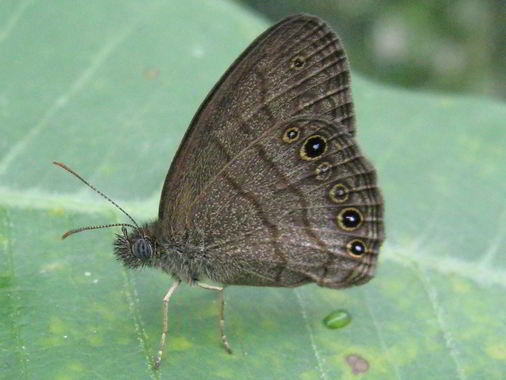
Any discussion on the butterflies of the cool shade would be incomplete without mentioning the Satyrinae. The members of the Satyrinae family are mostly drab brown and are found in cool areas, usually close to the ground. Hermeuptychia hermes is probably the most commonly encountered Satyrinae. It is identified by the sequence of eyespots on the underside of its lower wing – 2 large dark/2 small light/2 large dark. Like all members of this family, they are attracted to ripe fruit.
